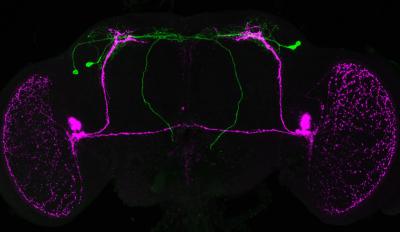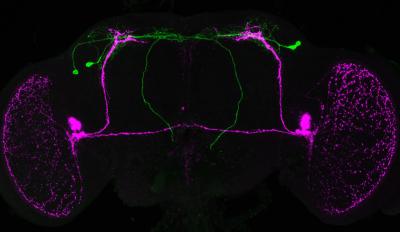
Credit: Photo: AG Wegener
Whether fly, mouse or human, circadian clocks are the central mechanisms that drive circadian rhythms in all animals. However, the notion of one, central clock regulating the timing of all the body's processes is not true. Rather, most organisms have a multitude of circadian clocks: a central clock in the brain and various peripheral clocks in the organs and systems.
Yet, it is still largely unknown how these clocks communicate with each other, how they synchronize and whether the central clock sets the time for all other units. An international team of scientists from the University of Würzburg and the Universidad de Valparaiso (Chile) recently shed light on the link between a central and peripheral clock in the fruit fly and provided experimental proof of the so-called "coupled-oscillator model" comprising a "master" clock and multiple "slave clocks".
The Würzburg part of the study was conducted by Christian Wegener, Professor of Neurogenetics at the University of Würzburg's Biocenter, postdoc Mareike Selcho, the Ph.D. students Franziska Ruf and Jiangtian Chen and the student Gregor Bergmann. The scientists publish their findings in the current issue of the journal Nature Communications.
A hormone gives the cue to hatch
"In the study, we focused on the neuronal pathway that connects the circadian clock in the brain of the fruit fly with a peripheral clock in the prothoracic gland which produces steroid hormones," Christian Wegener explains. What makes the gland so interesting is that it produces the hormone ecdysone which gives Drosophila the signal to "grow up" meaning that it defines the moment in which the fruit fly hatches. The hatching process follows a strict schedule: It usually takes place only in the early morning.
There is another aspect that makes this pathway and the gland so interesting from a scientific point of view: "Humans have a comparable system that works in a similar manner," Mareike Selcho says. Here, the adrenal cortex has a similar function as the prothoracic gland.Yet, instead of ecdysone it secretes glucocorticoids which are believed to play a central role in synchronizing the circadian clocks of mammals. When synchronization is permanently dysfunctional in humans, this can result in various diseases from depression to cardiovascular diseases and metabolic disorders.
Communication between central and peripheral clock
Findings from earlier studies support the assumption that the central clock in the brain of the fruit fly communicates with the peripheral clock of the prothoracic gland. Hence, both clocks have to work for the flies to hatch at the usual times even when they are kept under constant conditions, i.e. in the absence of a regular day-and-night cycle. In the presence of a normal day-and-night rhythm, as occurs in nature, a functioning peripheral clock alone is sufficient to sustain hatching in the early morning. Failure of the central clock is no problem in this case.
In their search for the connecting pathway, the Würzburg scientists concentrated on specific neurons that could facilitate the contact between the central and the peripheral clock, the so-called PTTH neurons. "They should be ideally suited to connect the clocks just because of their spatial arrangement," says Christian Wegener.
In fact, the Würzburg scientists were able to show that the PTTH neurons establish a direct link between the brain-based clock of the fruit fly and its peripheral counterpart. They showed in experiments that the central clock neurons produce a special neuropeptide which transmits time information to the PTTH neurons. The PTTH neurons in turn forward the information to the pacemaker of the prothoracic gland and regulate the production of ecdysone.
Confirmed by experiments in Chile
The Würzburg researchers found their master and slave theory confirmed by the work of their Chilean colleagues. The researchers in Chile had conducted a number of experiments in which they had artificially slowed down the circadian clocks of Drosophila in various combinations and observed the impact on the hatching behaviour.
The results: When both clocks run more slowly, the "hatching rhythm" increases from normally 24 hours to over 27. A similar effect is observed when the peripheral clock continues to run at regular speed and the central clock is slowed down. Vice versa, however – i.e. normal working central clock and slowed down peripheral clock – the hatching behaviour remains unchanged at a 24-hour interval.
"This is the first comprehensive experimental description of a pathway that links circadian clocks and it shows that the coupled-oscillator model is actually true in certain cases," says Christian Wegener. But he admits that science is still a long way from understanding the exact interactions of the circadian clocks. After all, the recent findings illustrate that the diverse mechanisms are heavily interwoven and provided with feedback loops. So Wegener is certain that "it is not going to be easy".
###
Central and peripheral clocks are coupled by a neuropeptide pathway in Drosophila. Mareike Selcho, Carola Millán, Angelina Palacios-Muñoz, Franziska Ruf, Lilian Ubillo, Jiangtian Chen, Gregor Bergmann, Chihiro Ito, Valeria Silva, Christian Wegener, and John Ewer. Nature Communications, DOI: 10.1038/ncomms15563
Media Contact
Dr. Christian Wegener
[email protected]
49-931-318-5380
@Uni_WUE
https://www.uni-wuerzburg.de/
############
Story Source: Materials provided by Scienmag





